
Prepare for Your Next Morocco Adventure Holiday
MOROCCO PREPARATION
The following checklist outlines some of the other things that you will need to make sure you have organised before you leave on the expedition. We have also given suggested sources of further information on each item. As with all aspects of the trip you can contact Adventure Alternative for further advice and support.
FLIGHTS
Adventure Alternative is not a flight ticketing agent so we do not sell flights directly. However, the flights to Marrakech are usually fairly straightforward to book. Amongst others, Ryanair, Easyjet and British Airways fly direct from London as well as from other regional airports.
It is worth checking online comparison sites such as Kayak, Ebookers, Sky Scanner etc. If you enter the departure airport as just ‘UK’ then you will get the options leaving from Manchester, Stansted, Luton, Gatwick etc. You often get the best prices if you either book a long way in advance or at the last minute. Needless to say, if you book at the last minute you are likely to have less choice and also have the possibility of there being either only expensive flights left or even none. It is best to book early.
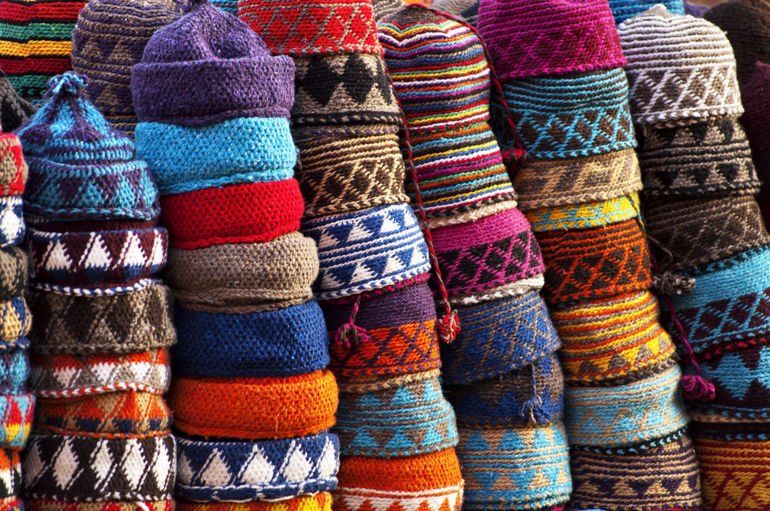
The itinerary for your trip starts on the evening of the day described as “Day 1” on the itinerary. It is best if you can arrange a flight that arrives in Marrakech sometime between lunchtime and late afternoon on this day. That way you will have a bit of time to settle in and take an optional walk out into the city before we all have dinner that evening.
The itinerary ends on the day shown as the final day on the itinerary. We will usually be driving down from the mountains that morning which takes between one and two hours. We should be back in Marrakech by lunchtime so if you can book a flight with departure time from late afternoon onwards that will give us time to get to the airport and for you to check in.
If you are at all unsure about the flight dates or times that you need to book then please do speak to us before making a booking.
INSURANCE
You will need to take out personal travel insurance for the trip. You need to make sure it covers all the trip locations, altitudes and activities and also cancellation.
You need to buy coverage as soon as you book your place on the trip and buy your flights so that if something happens before the trip that means you can’t travel, you will be able to claim the flights and trip cost back. A few providers that are worth checking are; Campbell Irvine, the BMC, Snowcard, STA Travel, Insure and Go. Note that the BMC include Morocco within their “Europe” coverage so you don’t need a worldwide policy.
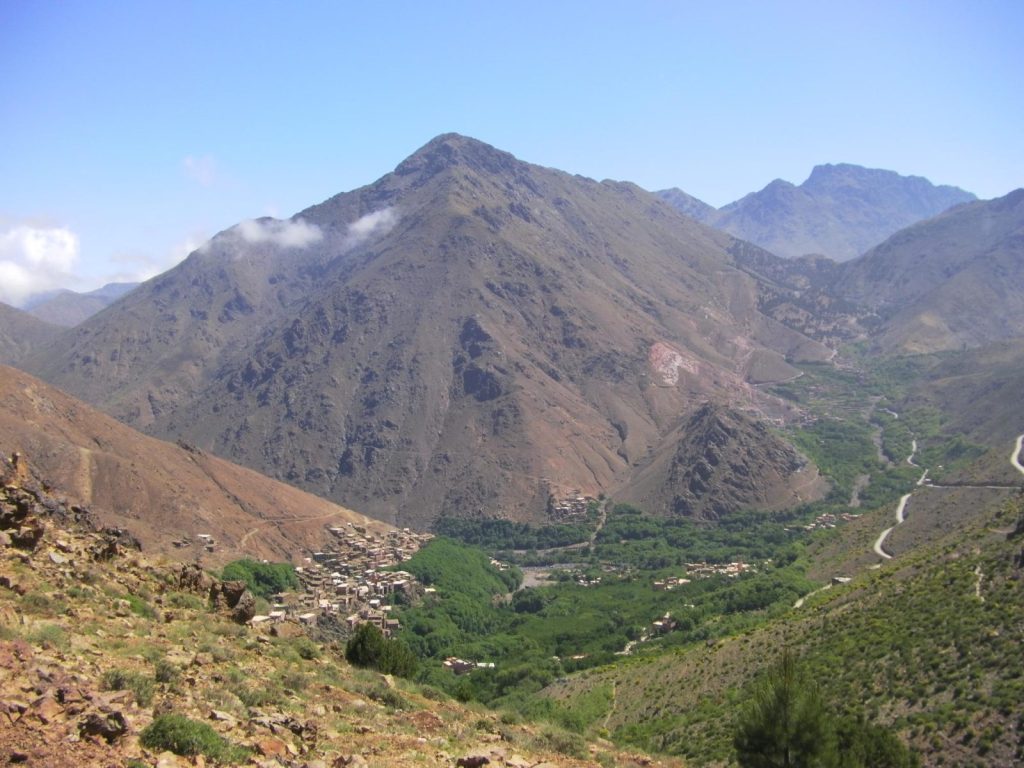
VACCINATIONS & MEDICATIONS
You will need to check what the requirements are for vaccinations, immunisations and medications on the specific trip you are doing. You will need to make an appointment with your GP or ideally a travel health clinic for at least 6 weeks before travel. When you go to the appointment you need to take along details of the trip including the country you are going to, the areas you will visit and the activities you will be doing. All of these factors, plus your own medical history, will affect what vaccinations you are advised to get or update.
Adventure Alternative operates an account with Interhealth who can give you medical and vaccination advice. You can also get advice from organisations such as the NHS and the FCO. The Fit For Travel and Live Well campaigns also give good advice for staying healthy while you are away.
VISA REQUIREMENTS
Different countries have completely different visa requirements for people travelling to them. These requirements can also vary depending on your own citizenship, what you will be doing and how long you will be staying. If you are a UK citizen the first place to look is the UK Foreign & Commonwealth Office (FCO). Their website has a page for each country and a section called “Entry Requirements”. If you are not a UK citizen you will need to contact the destination country’s embassy in your home country or the foreign office of your own country.
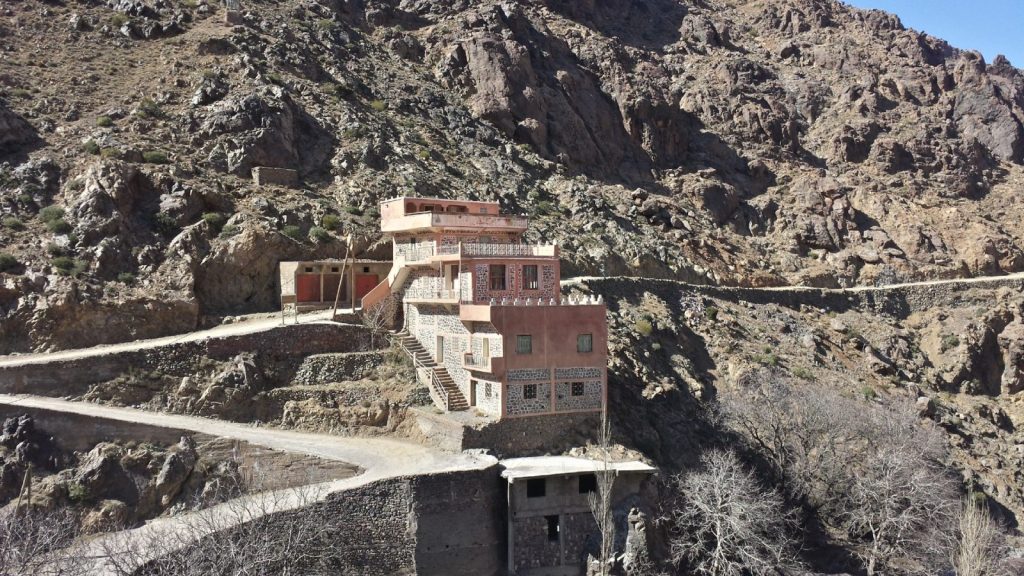
MONEY
The currency in Morocco is the Moroccan Dirham, this is normally abbreviated to MAD in currency information. There are usually around about 13 Dirhams to the GB Pound but you can check the current rate here. Do bear in mind that this may not be the actual rate that you get at an exchange bureau though!
The Moroccan Dirham is a ‘closed currency’ so, strictly speaking, you cannot get dirhams before you enter Morocco. There is an exchange bureau next to the luggage collection belts in Marrakech Menara airport, although the rates may not be very good. We can show you where you can change money at a good rate when we go into Marrakech city. You can also get money out of cash machines in the city, though you will need to check the rates and charges offered by your bank and you may need to put a travel marker on your account before you travel to prevent it being blocked.
In terms of how much money you will need, the following should give a rough idea of costs:-
- Dinner & drinks in Marrakech ~ 100-200 MAD
- Soft drinks / Mineral water / chocolate at refuges (total) ~ 100-200 MAD
- A hot shower at Mouflon Refuge (next to Nelter) ~ 20 MAD/shower
- Firewood supplement at Nelter Refuge (Winter Only) 10 MAD/Night
- Tips for Moroccan Staff (optional- given on last night) ~ 250 MAD
- Some small souvenirs (depends what you buy!) ~ 250-350 MAD
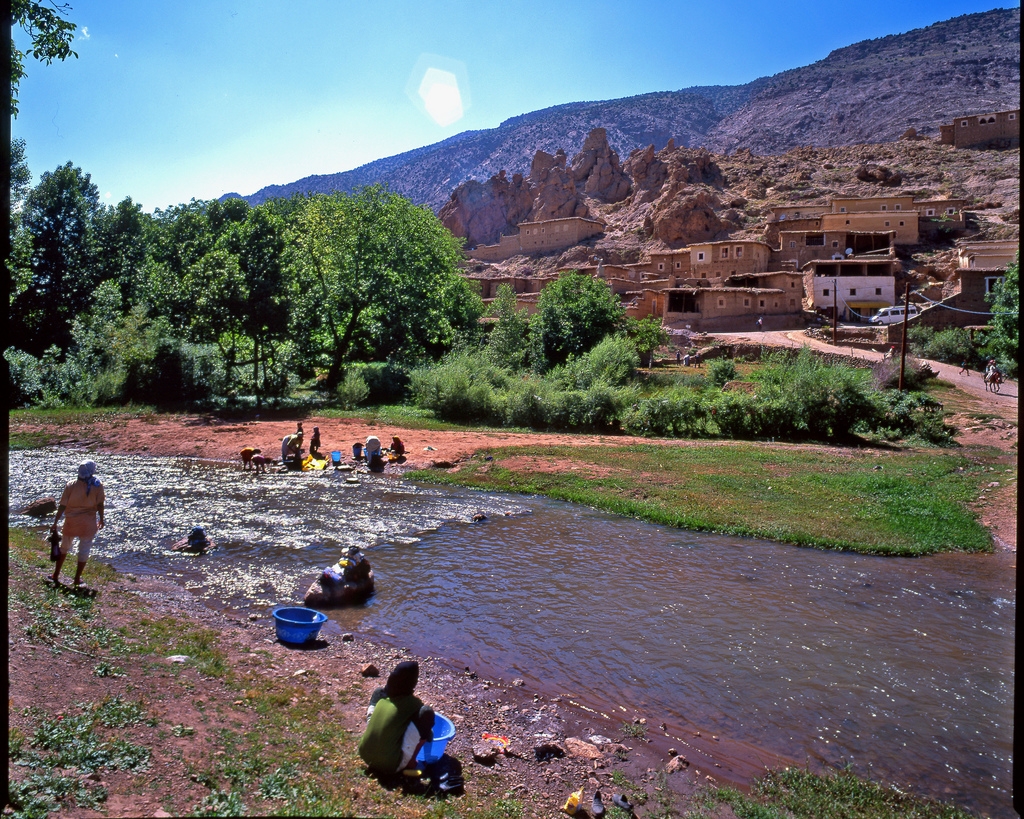
COUNTRY INFO
In order to get the most out of your trip, it is always good to read a bit about the history, geography, culture, customs and language of the country you are travelling to. There is a lot of information on the Adventure Alternative website and also on the FCO website and part of the FCO Know Before You Go campaign.
HEALTH AND SAFETY IN MOROCCO
The exotic nature of Marrakech may lead to some degree of culture shock and the rugged landscape of the Atlas may be wild by some standards. This should not be seen as a scary or intimidating thing, quite the opposite, it is a big part of the experience of adventure travel. To that end, we do not set out to wrap you up in a bubble of western European culture. However, we recognise that all the uncertainties of travelling to a new and different place can be a bit daunting and can make you a little bit nervous as well as excited. Please be assured that we have our friendly and approachable staff on hand at all times to help you to take in all the new experiences and deal with any unexpected problems.
In order to help you to be as prepared as possible for your trip, we offer the following advice and tips on staying healthy and comfortable.
BEFORE YOU DEPART FOR MOROCCO
Before you leave you need to make sure that you that you complete our medical form if there are any pieces of information that you think are relevant but that are not specifically addressed on the form please do let us know. It is always better for us to be informed in advance of anything that we may need to account for.
You need to make sure that you receive all the relevant immunisations. You can get free information on which ones you need from your GP and further information is also available via our account with Interhealth and from the NHS. The process of getting the immunisations will usually need a period of time for booking in the first appointment and then also a couple of visits over a period of a month or more for all the jabs to be actually done. Therefore you need to contact your GP or travel clinic as early as possible to allow time for this process. You will be given a card or booklet that will record what jabs you have had. Take this record to each appointment and keep it safe for future reference. It is also worth noting that some of the jabs can be followed up within a certain period of say 6 months or a year to give more long-lasting protection of up to 10 years.
IN COUNTRY HEALTH TIPS FOR MOROCCO
Once in Morocco, there are a whole host of things that you can do to keep yourself healthy and comfortable. Some of these may seem obvious but we include them as they are all things that we have seen in our considerable prior experience:-
KEEP YOUR HANDS CLEAN
This is something that you will, of course, do to some degree at home anyway. However, when you are away there will be bugs to which your body may have no built up immunity to and general cleanliness in some places is not the same as at home. Toilets may have limited facilities for washing your hands. In this cas,e you will need to bring a small bottle of hand sanitiser gel, these products do not need water and will sanitise your hands as the gel evaporates away. At the same time, it is a good idea to keep your fingernails short and clean, a small nail brush can be invaluable in this capacity. If you bite your nails or suck your thumb, this is the time to kick the habit!
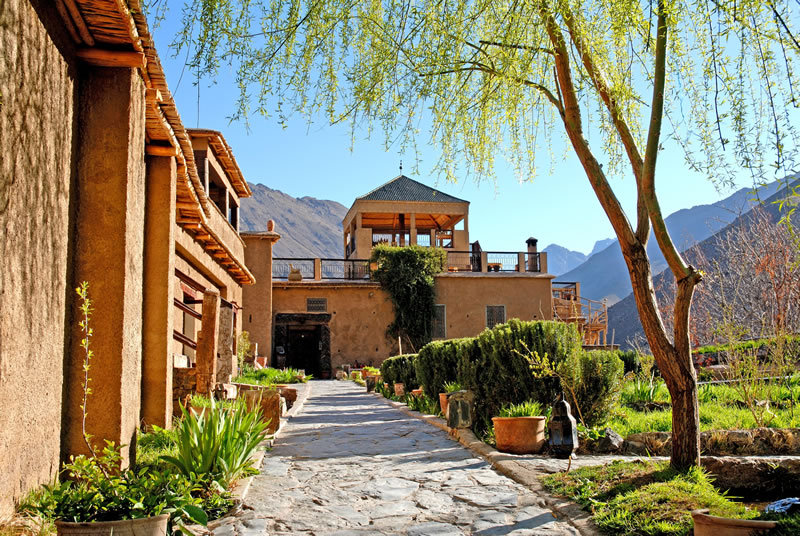
We also offer luxury treks at various Kasbahs in the Berber villages.
SUN PROTECTION
Protect yourself from the sun. We all enjoy the feeling of the warm sun on our face, however, exposing your skin to too much sun can do a huge amount of damage in the long and in the short term. The sunlight up high in the mountains can be much more intense than that which you are used to and you can get burned very quickly. It is important that you have a broad spectrum, high SPF factor sunscreen with you and also that you have options in terms of lightweight long sleeved and legged clothing and a hat that will shade your face, neck and ears.
Note that it is theoretically possible to get sunburned through some clothing materials, some trekking and outdoor clothing now comes certified with a UPF rating giving the proportion of UV radiation that is blocked by the material. It is also worth having a reasonable pair of sunglasses. Also, note that some low-quality sunglasses may shade your eyes without blocking the potentially harmful UV radiation, this has been reported to be more dangerous than no glasses at all as your pupil opens up in the shade and lets even more UV in. Current advice is to look for products with either a CE Mark to British Standard BS EN 1836, a UV 400 label or a statement that the sunglasses offer 100% UV protection.
Aside from the effects of the sun on your skin, there is also the danger of heat exhaustion and its more serious development, heat stroke. These are both caused by the body’s internal temperature being raised beyond its functional level and can lead to potentially serious complications. The way to minimise the risk is to stay out of the worst of the sun, particularly in the middle of the day, to keep cool and not to overexert yourself. You will also need to stay hydrated to help your body to cool its self through sweating. A hat can be invaluable for keeping the sun off your head and face.
WATCH WHAT YOU EAT AND DRINK
All the food prepared by our own staff will be safe and indeed delicious. However, at some points, you may choose to purchase food or drink independently. Most of the time this food will be perfectly safe but of course, we are not able to guarantee this. A few bits or advice can help to avoid nasty stomach bugs.
Try to order dishes that will have been cooked to a high temperature, for example, if a well-cooked piece of meat or potato arrives in front of you, you will be benefitting from the sterilising effect of the cooking temperature. Note that this is not totally fool proof as some bacteria will not be killed by cooking. Avoid cold dishes and ones that might have been cooked in untreated water, such as salads. If you eat fruit, choose ones that have a skin or peel that you will not eat, like bananas. Order bottled or boiled drinks like sodas or tea, always check bottles to see that the caps are still sealed.
Try to get into the habit of taking some “me time” where you wash your hair, have a good wash, sort out your stuff etc. We will provide plenty of opportunities for you to wash your clothes yourself or to pay a small fee for others to do so for you. Having a wash and putting on a full set of clean clothes may not sound like much but can have a very restoring psychological effect. Keep your gear in order, you need to periodically check your stuff and organise it so that you can find it easily and also check if you have lost or broken anything.
If you injure yourself in any way please inform your leaders immediately even if you don’t think that there is anything they will be able to do for you. We will offer advice and help to monitor you. If you have a cut or graze for example you will need to keep it clean and change the dressing regularly. Even a simple splinter or thorn can develop into bigger problems if you don’t look after it.
You may feel embarrassed to approach us and talk about certain issues such as if you develop diarrhoea or constipation. However, it is very important that you do talk to us. These are things that do occur here and there and you certainly won’t be the first or the last to be faced with such problems. We may be able to offer advice ourselves on how to help sort out such problems or we will seek further advice on your behalf where necessary. It is important that we are aware of any problems so that we can monitor them and take required actions as early as possible.
TAKE TIME TO ACCLIMATISE TO ALTITUDE
As you travel higher in the atmosphere, as you do when ascending the mountains, the air pressure reduces and therefore for every lungful of air you are actually getting fewer molecules. The result is that your system is gaining less oxygen. Clearly having less oxygen will affect you in a number of ways, chief among these is your ability to do physical activity.
Almost everyone will feel more lethargic, have a headache at some point and may feel less inclined to eat. Luckily our bodies do adjust to the altitude, primarily by producing more red blood cells so as to carry more oxygen per litre of blood. However, this adaptation takes some time to take place. The amount of time that it naturally takes any given person to acclimatise and how effectively they do so is mainly a matter of luck. It is controlled principally by genetics and is not affected by fitness.
There are a number of things that we can do to help our bodies to acclimatise and to minimise any negative effects; ascend slowly and in stages, stay hydrated, stay well nourished. There are certain medications that can be used but these are best left as a backup plan. It is important to be honest about how you are feeling, we have plenty of time to get to where we are going and the schedule is made flexible enough to spend additional days at a lower altitude if necessary.
TALK TO US AND YOUR TEAM-MATES
Everyone who travels away from home and loved ones for any period of time may feel some degree of homesickness. This can come in waves and can be made worse if you are tired or not feeling one hundred percent. Often, after the first excitement of meeting new people and seeing new sight,s you may hit a bit of a low in terms of energy and morale. What starts off as just a passing thought can become more of a problem over time. One of the best remedies is simply to talk about it. This may be with your teammates or with one of our staff. The most important thing is to be assured that our staff have dealt with the same concerns in others before you and indeed will have experienced the same thoughts and feelings themselves. We will always talk to you in confidence and will deal with any issues subtly and sensitively.
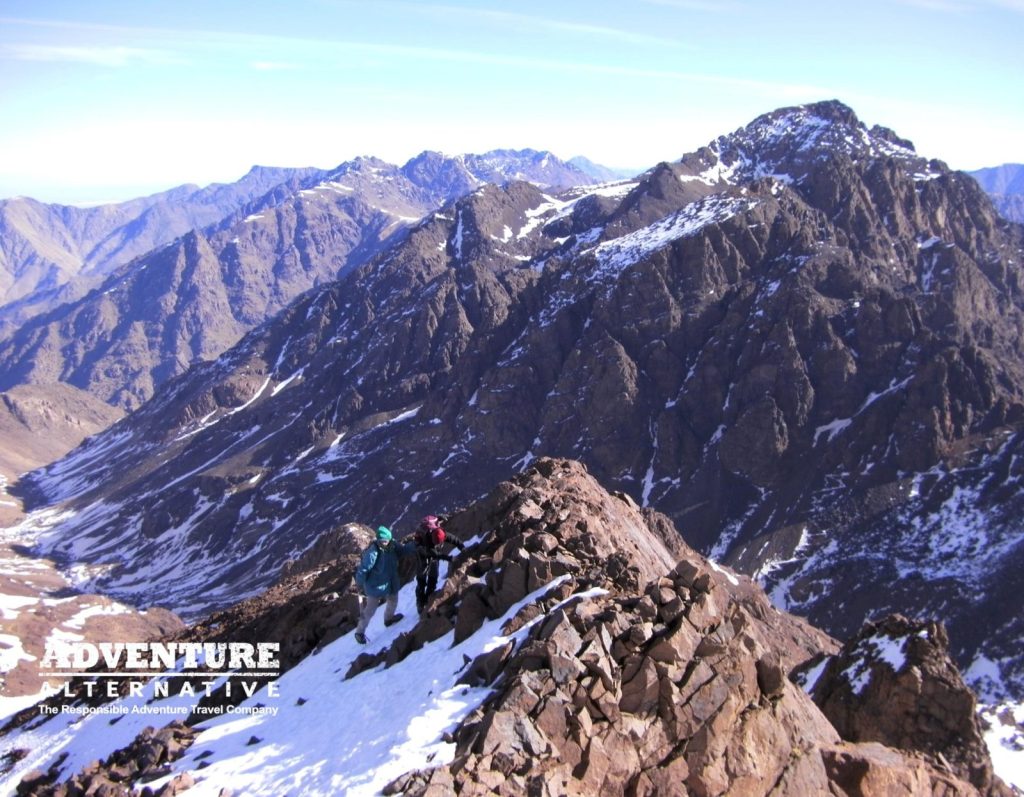
MOROCCO SEASONS
From our time in Marrakech to 4000m up in the High Atlas, we will, of course, see a large change in temperature and exposure conditions. On the trek and the mountains, we will need to be prepared for potentially cold conditions with the possibility of precipitation as rain or snow.
The following table gives a general picture of the annual weather variation in the valley close to Imlil where our Toubkal area treks begin. (click on it to enlarge) Obviously, conditions at camps/refuges higher up and on the peaks will be colder and the wind chill will greatly lower the experienced temperatures. To convert the temperatures for higher altitudes you would usually take off another 6-10 degrees C per 1000m of altitude gained.
There are also detailed annual average temperatures charts at a website called Weatherspark and another also with rainfall statistics called World Weather & Climate. You can get good forecasts for the next 6 days at different altitudes on Toubkal at Mountain-Forecast.
As with the weather anywhere, the temperatures on the treks are slightly unpredictable. How hot or cold it actually feels is also affected quite a lot by whether you are in direct wind/shelter or sunlight/shade. However, the following will give you an idea of what to expect and how you should plan your clothing and equipment to suit.
CONDITIONS & CLOTHING FOR SUMMER TRIPS (MAY & SEPTEMBER)
Expect the daytime temperature in the mountains to be between 10 and 25 degrees C. As previously mentioned, temperatures usually drop by a degree or so per 200m of altitude gained as well, so they will vary according to where we are on the trek. For example, on the top of Mt Toubkal, it could potentially be several degrees below freezing.
Lower down, we will need to be prepared for maximum daytime temperatures of around 30 degrees C or perhaps slightly more, which will feel quite hot if we are out of the breeze and the sun is bright. If it is cloudy and there is some wind then on the higher ground and summits we may also have conditions during the day that could feel more like 0 degrees C or lower.
For some summits, we will also be making an early start. At this time we may spend the first few hours of the trek in the shade of the surrounding mountains before the sun comes up. We will therefore probably start with a light jacket or top on, which we will remove when the sun hits us later on.
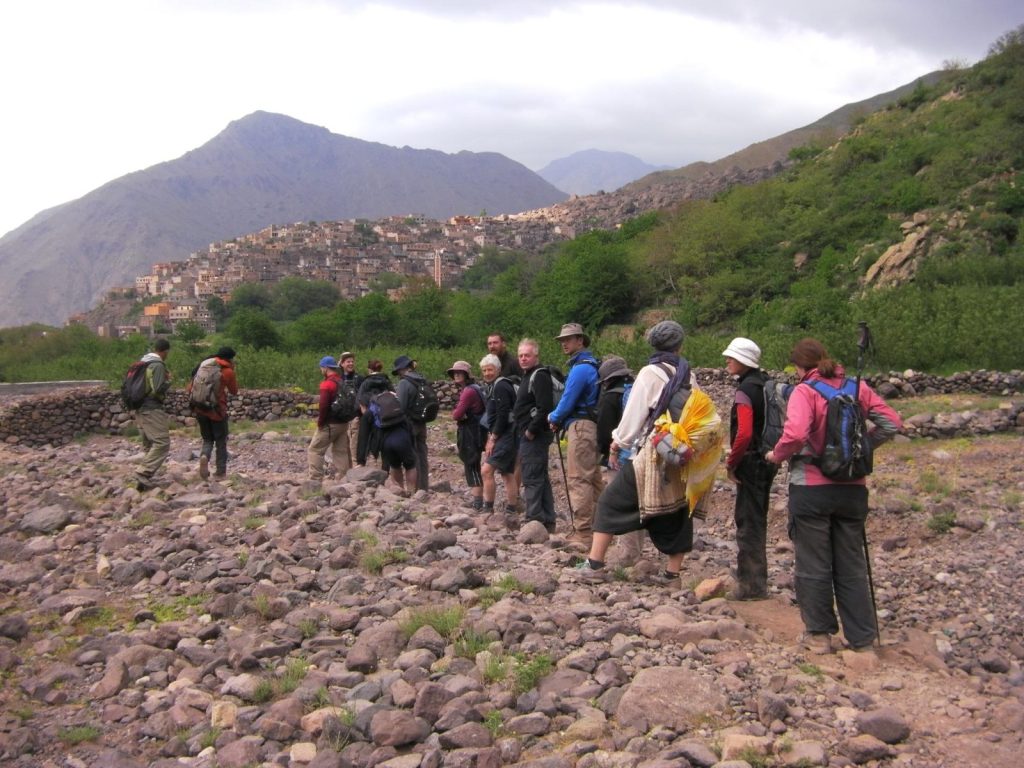
As an example of clothing to wear;
In the lower valleys, we will probably set off in shorts or light trekking trousers, a lightweight trekking shirt or top and maybe a light micro-fleece or softshell top if the sun is still below the peaks. By mid-day, we will be in single layers of lightweight clothing, sun hat, sunglasses and sunblock on any exposed skin.
On the upper parts of the trek and peaks, we may be leaving quite early in the morning in order to complete the hardest part of the day’s ascent in the cooler conditions. We may leave the camp or refuge in trousers, lightweight top, microfleece or softshell and even perhaps a warm hat. As we begin to climb and the sun comes out we will probably be down to just our lightweight layers and the sunhat and sunglasses will come out. Once we are up on the summit the air will be cooler and, especially if you have been sweating, you will soon need to throw on an extra layer and maybe your hard-shell windproof jacket.
In all situations, you will need to have an extra insulating layer, a waterproof hard-shell jacket and thin hat and gloves in your day-sack in case the weather changes or we are forced to remain stationary for any reason.
At night, temperatures would normally not drop below around 0-5 degrees C at our highest sleeping places such as the Nelter Refuge. But again, there is obviously some variation year to year. It is worth having a good sleeping bag to ensure a good night’s sleep. We usually recommend a 3/4 season sleeping bag for our summer treks. If you only have a warmer bag then you can use this and just leave it unzipped if it is hot. When selecting sleeping bags for this trip, look for something with a comfort temperature of around 0 degrees C or lower.
CLOTHING FOR WINTER TRIPS
Expect daytime still-air temperatures to be between 5 and 20 degrees C but factor into this that we will see a huge variation in the actual perceived temperatures. If you are high up, in the dark or shade and the wind is blowing across the snow it can easily feel more like -15 deg C and if you are climbing a steep incline in still conditions at mid-day in the full force of the sun it can feel more like 25-30 degrees.
Our clothing needs to be adaptable to the variation in conditions and the best way to achieve this is through a layering system, preferably with zips in the front and even armpits. These zips can be opened and closed as we move to regulate temperature without needing to stop and physically remove garments. Another very useful way to regulate temperature is simply by putting on or taking off a hat and gloves. A couple of pockets in your outer layer can be invaluable for this, or even stuffing them down the front of your top.
The kit list provided can be used as a guide but you may have clothing systems that you have found to best suit your own preferences. The general idea is to be equipped with shell layers for wind and precipitation, insulating layers for temperatures down to perhaps -10 or even -15, base and mid layers for layering flexibility and good quality winter boots with fully compatible crampons.
As mentioned above it could be -5 leaving the refuge in the dark of the early morning, -10 on the summit including wind-chill and +20 or more with strong UV in the valley as we return to the refuge in the afternoon. It is likely therefore that you will leave the refuge in the morning wearing trekking trousers, maybe shell over-trousers, base-layer, warm mid-layer, soft-shell, belay jacket, windproof layer, two hats and thick gloves. By the time you return in the early afternoon, you are likely to be wearing just thin trekking trousers, thin long sleeved base-layer top, sun hat and sunglasses with everything else stuffed into your day-sack.
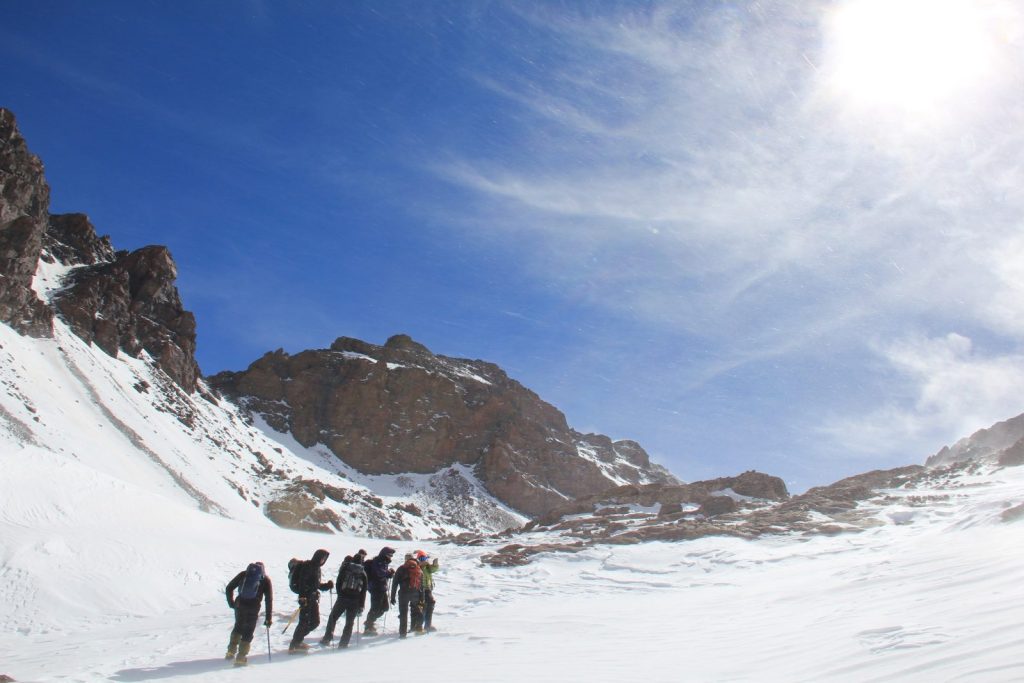
SNOW ALONG THE TRAILS
The snowline can vary quite a lot between Imlil and the Refuges. At some times you can walk pretty much all the way to the refuge on the rocky/dusty path. However, you will need to be prepared, in terms of footwear and clothing, for the possibility of there being snow underfoot and potentially cold conditions, well below freezing.
The path to the refuge is not steep so even if there is snow on the ground it is very rare that crampons would be needed to get to the refuge its self. We would usually have our crampons in our mule bag anyway unless our local contacts report difficult conditions. As we get closer to the refuge there may be some ice and old snow on the ground that can be slippery. However, we will move slowly in this case and take whatever steps needed to get through.
The other aspect of walking on snow, aside from grip, is that it makes your feet a lot colder. This is especially true if there is fresh snow in the ground into which you are sinking. Therefore, even if you are going to change to different boots for the peaks, you do need to have good quality, stiff and supportive boots of 3-4 season warmth rating for this lower part. It is a good idea to have some nice warm socks and boots sized to accommodate them inside too. If you would like to send us the make & model of your boots, or a photo, we can let you know if they are likely to be OK. Gaiters are also extremely useful for keeping any snow out of your boots.
In terms of warm clothing, you will definitely appreciate some good warm layers. A good warm down or synthetic jacket is essential, although it does not need to be one of the huge expedition-style ones. This should travel with you in your day pack even when you are walking in the lower valleys. You also need other warm fleece/wool layers for your body, hat, warm gloves and windproof layers. It is more likely to snow than rain, but it is not impossible that we could have rain or sleet lower down in the valleys. I usually layer-up with my upper body and head and wear just normal trekking trousers, though slightly thicker, warmer trousers like softshells may be useful to have as an option.
AT THE REFUGES
For your time in the refuge; the building, in general, is not heated and can be quite cold. As we are in a valley running North-South between steep peaks, this means that the direct sunlight arrives in the valley quite late in the morning and disappears again quite early. I tend to put on warm base-layer leggings and top as soon as we get there, along with other layers on top.
There is a shower/toilet area downstairs that can be rather cold, a common dining area on the ground floor that is moderately cold and a common room on the ground floor that has a log burner in the corner and can be very warm. The sleeping rooms are upstairs on the first floor and can be moderately cold. To get a good night’s sleep I would say you will need a sleeping bag that has a comfort rating down to -5degC. Though if you tend to get cold at night then a warmer rating or a silk/fleece liner can be a good idea.

Boots generally stay in the entrance hallway in big racks so it is good to have either some big, thick socks + flipflops/crocs or some down booties to walk around the hut in. Unfortunately, hut slippers are not supplied like they are in the Alps.
With all of this, I would say that it is better to bring too many warm layers than not enough. We will have various briefings and chats in Marrakech and in Imlil so we can always review what you have there and leave any excess kit in Imlil.
We appreciate that it can be hard to visualise what the conditions may be like, and therefore what to bring. Hopefully, the information and examples above will help you to plan. We have a Morocco Kit list for both summer and winter that is worth a look for specific kit items. However, if you have any queries or questions on kit, then please do get in contact with us to discuss it further.
ACCOMMODATION IN MOROCCO
During our trips to Morocco, we stay in a range of different locations, which vary to some extent in what facilities they offer. We give the following examples in order to help illustrate what to expect.
MARRAKECH – CITY RIAD
In Marrakech, we generally stay in one of a few city riads that we use. The exact one may vary depending on the group size and composition. Riads are a traditional style of building in the old part of Marrakech. The rooms are usually arranged around, and open out onto, an open central courtyard and the exterior of the building either directly abuts other buildings or is generally very closed with few windows. There is very often a roof terrace for relaxing on and viewing the famous city roofscape and backdrop of the Atlas Mountains. We will generally stay in twin rooms with sprung or foam mattress beds with all bedding provided. Virtually all the time, rooms will be ensuite with a western-style toilet, bathroom and shower. Breakfast is usually provided at the riad but our evening meals are likely to be taken at a nearby restaurant.
IMLIL – BERBER GUESTHOUSE
Once in the mountains, our first night is usually spent in a small guesthouse run by a local Berber family, almost everyone who looks after us will be part of the extended family of our host. The guesthouse is fairly basic and slightly eccentric, but clean, very welcoming and an authentic experience of life among a local family. We will stay in a twin or even triple rooms depending on our group size. In some cases, the single beds may be fairly narrow and low to the ground. Bedding is provided in the form of sheets and woollen blankets, but these may not match! All of the rooms are ensuite, with a shower and western-style toilet, although one does not have a sink so you wash your hands under the shower head. Hot water can be limited here, especially if we have a larger group. Therefore it is courteous not to take too long in the shower. It can be cold at night up in Imlil, even in the summer, so you will need to make sure that you have some warm layers to wear in the evenings as there is no central heating here. All our meals in Imlil are freshly prepared by the family at the guesthouse. If the sun is out we will often eat on the roof terrace with great views over the valley and with overhanging cherry trees providing tasty snacks in early summer.
OTHER VILLAGE GUESTHOUSES
Locally owned and run guesthouses in the villages off the main tourist trails will be basic but welcoming and authentic. Most will have showers and western-style toilets but some may be squat-type. Rooms will usually be twin or even triple rooms depending on our group size. In some cases, the single beds may be fairly narrow and low to the ground. Bedding is provided in the form of sheets and woollen blankets. It can be cold at night, even in the summer, so you will need to make sure that you have some warm layers to wear in the evenings as there is no central heating. Food will be prepared by our own expedition cook in the guesthouse kitchen and served in the dining area of the guesthouse.
KASBAH DU TOUBKAL
In Imlil, there is a very impressive and luxurious hotel inside a re-constructed Kasbah (castle) on a promontory above the village. It has been tastefully decorated to give a local feel whilst offering comfort and facilities of around four-star quality. We can arrange upgrades for individuals or groups who would like to stay at the Kasbah, though it does often become fully booked many months in advance so we can’t guarantee places. If you would like to discuss this option as part of your itinerary then do get in contact.
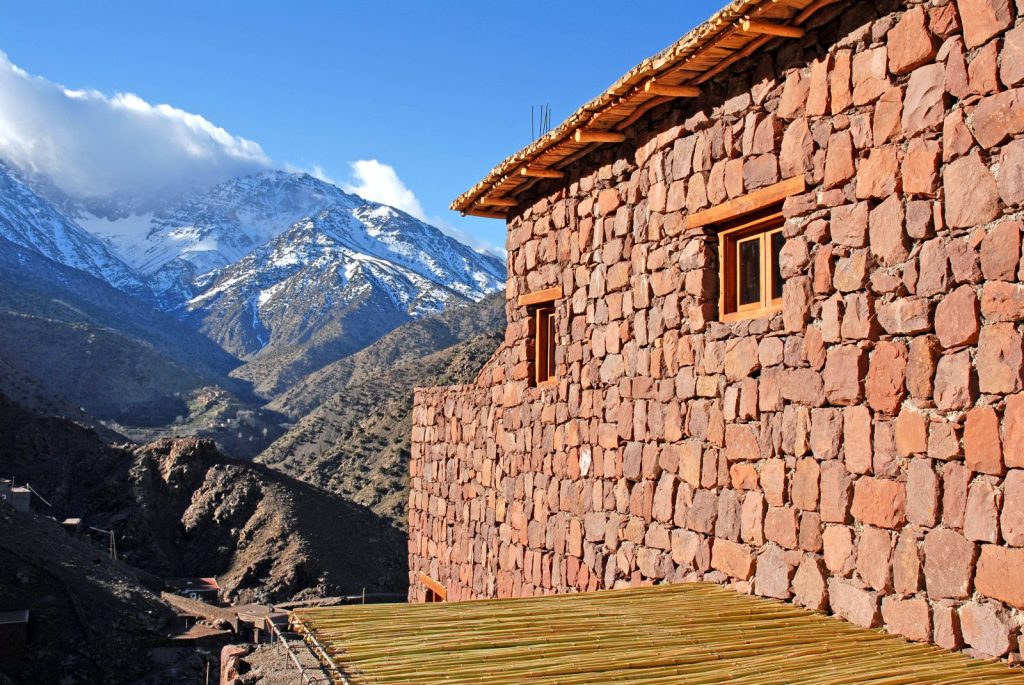
MOUNTAIN REFUGE – TAMSOULT REFUGE
One of the refuges we stay at on the summer programme is called Tamsoult. The refuge stands at the lower end of a series of terraced fields which are bright green in summer. It was recently fitted-out so it is in good condition and fairly luxurious for a mountain refuge. It is a large building of three stories at the downhill side. The lower floor houses a communal dining and relaxation area and the kitchen in which our cook will prepare our food. The middle floor, where the front door is, has an area for sitting and relaxing, a few dormitory rooms and the showers and toilets. Upstairs are more rooms, a toilet and a roof terrace. The rooms here are nearly all dormitory-style with large double bunk beds. Therefore you may end up sleeping next to another member of the group in a double bunk, so bring earplugs in case of snorers. This just depends on how full the refuge is and which rooms are available, we are generally able to have separate rooms for male and female members of the group, however, for small teams, we may all be in one room. There is one triple room which we may be able to reserve upon request for a supplement. Food at the refuge is prepared by our own cook in the communal kitchen.
MOUNTAIN REFUGE – NELTER REFUGE
Another mountain hut we use is called the Nelter Refuge. Its location right at the foot of Mt Toubkal means it is popular and sometimes busy. Accommodation at the refuge is basic but functional. The rooms are all dormitory-style with large sleeping platforms extending right across the room on two levels, containing a line of individual foam mattresses. This means that you may be sleeping between two other people, usually from our group but possibly from another if it is busy. Which spaces we have available will depend on how busy the refuge is and how big our group is, but generally, we will occupy a whole level in one room.
In some instances, we will book the annexe building and if we are a bigger group we may be the only one in there. The sleeping arrangements are the same here but the toilets are all squat-type and there is no shower. We can, however, use the facilities in the main Nelter refuge or in the adjacent Mouflon Refuge for a small fee. All our food here is prepared by our own cook and eaten in the communal dining areas.
THE NELTER REFUGE IN WINTER
The refuge buildings, in general, are not heated and can be quite cold. As we are in a valley running North-South between steep peaks, this means that the direct sunlight arrives in the valley quite late in the morning and disappears again quite early. It is a good idea to put on warm base-layer leggings and top as soon as we get there, while you are still warm from the trek, along with other layers on top. There is a shower/toilet area downstairs that can be rather cold, a common dining area on the ground floor that is moderately cold and a common room on the ground floor that has a log burner in the corner and can be very warm. The sleeping rooms are upstairs on the first floor and can be moderately cold. To get a good night’s sleep most people will need a sleeping bag that has a comfort rating down to say -5degC. Though if you tend to get cold at night then a warmer rating or a silk/fleece liner can be a good idea. Your big boots will stay at the entrance hallway in big racks so it is good to have either, some trainers or some big, thick socks + flipflops/crocs or some down booties to walk around the hut in. Unfortunately, hut slippers are not supplied like they are in the Alps.
MOUNTAIN REFUGE – CAMPING
In the summer we usually camp at the refuges. We will generally be in 2-3-man dome tents arranged on flat platforms at or near the refuges. Sleeping in the tents can be a great experience and in some ways more relaxing than in the refuges if they are busy. It can get a little cold in the tents, even in summer, so it is worth having a good sleeping bag and bed-roll/carrymat. We will use the toilets and cooking/eating facilities at the refuge and our own cook will prepare our meals.
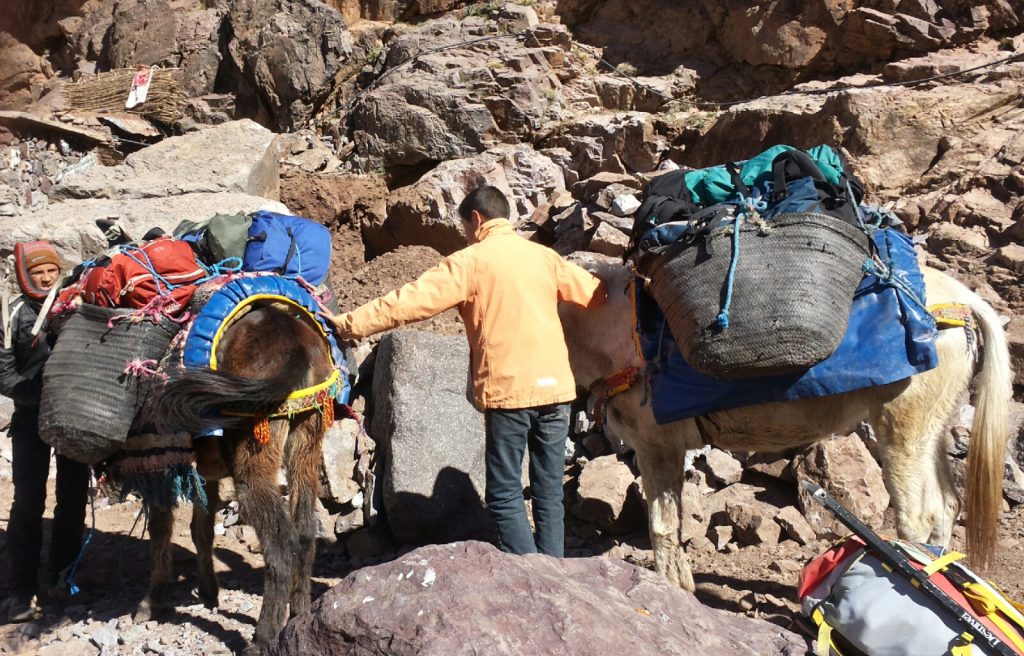
FOOD IN MOROCCO
As a general rule, the food we eat in Morocco will be dominated by fresh salads, vegetables and either couscous or pasta, followed by fresh seasonal fruits and accompanied by small semi-flat breads, hot, sweet tea made using fresh mint leaves. The food is all freshly prepared and is very healthy and nutritious.
It is often worth bringing a small supply of your own favourite high-energy snacks to eat during the trek if you find your energy levels dipping. Things such as jelly babies and energy bars/gels can be a useful backup in this case. As can dried fruits and nuts.
BREAKFAST
Breakfast is usually Moroccan in style with semi-flat bread, jams, honey and butter washed down with sweet, black mint tea and/or coffee. We will also sometimes have fried or boiled eggs.
LUNCH
Most days on the trek we will stop for around 30-40 minutes and have a good lunch. Our cook and muleteers will go on ahead of us and set up ‘camp’ to make our lunch. This may be at a local house of guesthouse or even just in a suitably attractive spot on the trail. The exact time of the meal depends on our speed covering the ground to the position previously agreed with our cook and muleteers. Therefore, if we are a slower group it may be 2 pm before we stop. Lunch is usually sweet mint-tea with bread and a huge platter of finely chopped salad such as tomato, pepper and onion along with sweetcorn, olives, sardines, beans and preserved meats. We will often have delicious local oranges as well.
Some days on the trek may involve taking lunch at locations to which the mules cannot reach. On these days we will carry a simple packed lunch. This usually consists of bread, sardines, cheese and fruit.
DINNER
Dinner does vary but a typical meal would be soup and bread followed by a chicken or vegetable tagine and couscous, rice or pasta. We often also have seasonal fruit for deserts such as oranges, watermelon or cantaloupe.
If you have any medical or religious dietary requirements then please do make sure that you give us details on your application and booking.
Book Your Adventure of a Lifetime Now
Discover our trips to other Countries
Adventure Alternative Articles
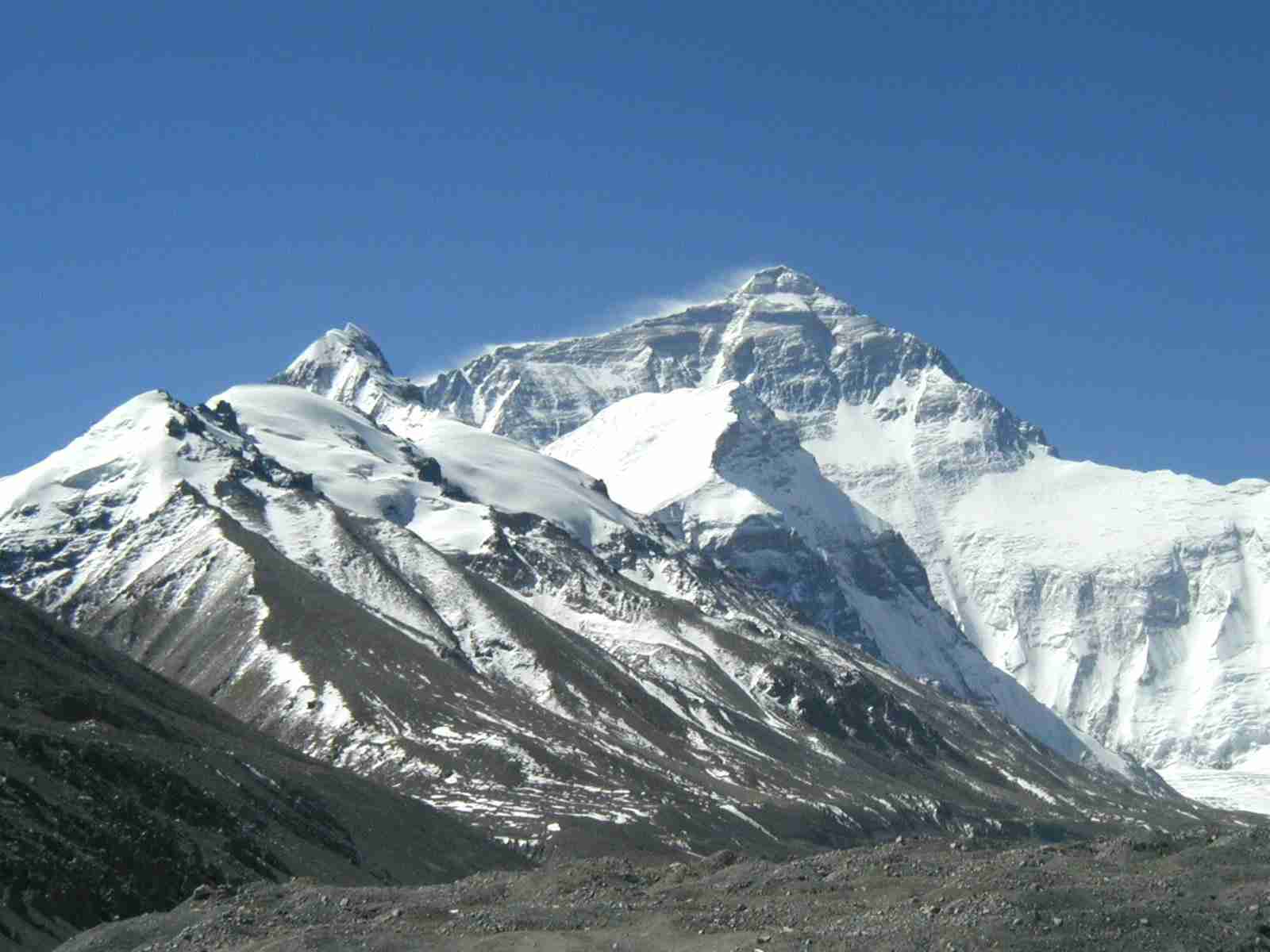
12 MONTHS, 12 MOUNTAINS
Climbing Calendar Ready for World Mountain Day In celebration of World Mountain Day, we've created a calendar for the year to make it easy for...
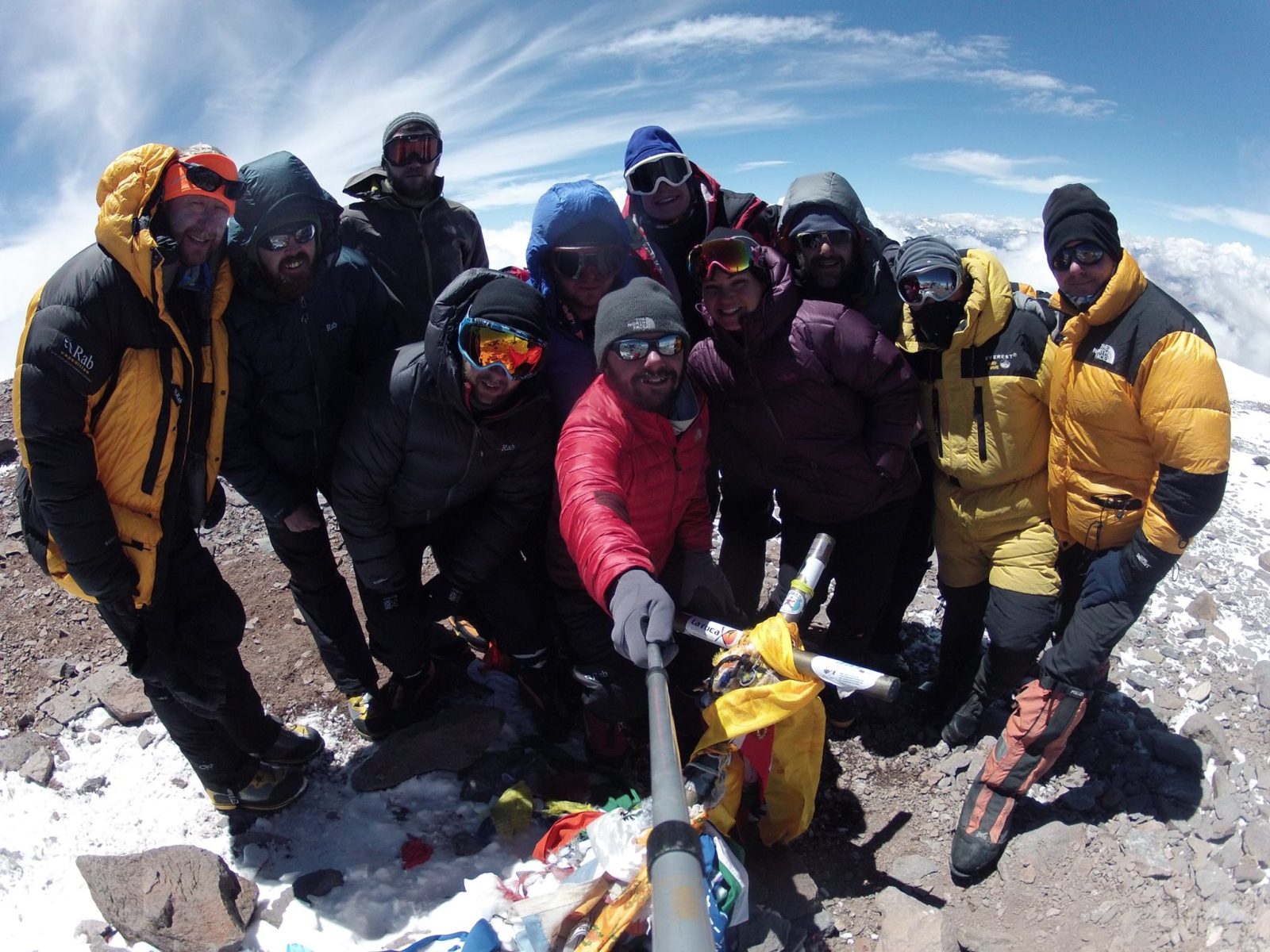
Mount Aconcagua Trip Review
January 2016 This year we had a team of twelve clients from four different countries – Iran, Ireland, England, South Africa and Argentina –...
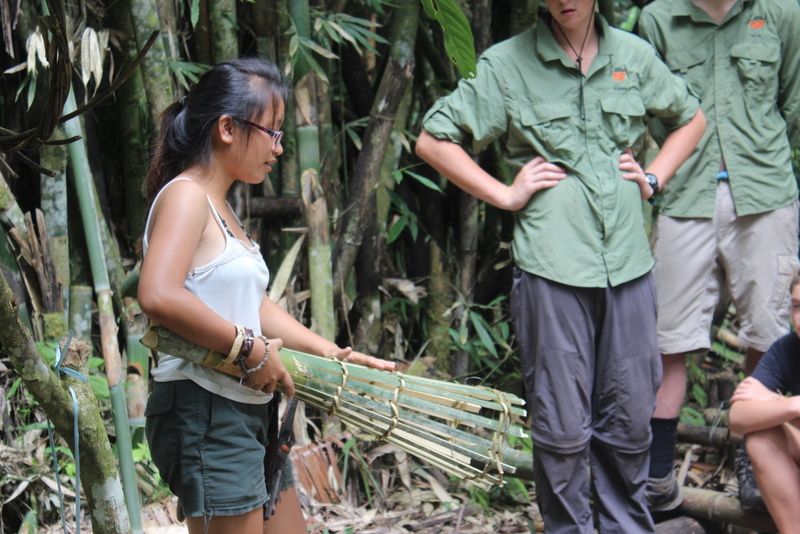
Alcey’s Survival Skills Course at Lupa Masa Jungle Camp
SURVIVAL SKILLS COURSE AT LUPA MASA JUNGLE CAMP | ADVENTURE ALTERNATIVE In celebration of International Rural Women’s Day, we’re talking...